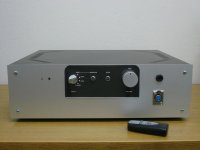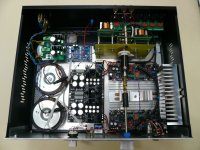Late night philosophical:
I have a few heat sink mounted DCB1 that I used for another project. I think I also have a few DCG3 pcbs somewhere. And I was thinking of making a few preamps for testing pots and shunt attenuators. The pre shall drive 100k short cabling.
First I was thinking to use the DCB1 as an input buffer, then pots exchanglable to a low gain DCG3 and then out. But maybe I should switch it. A DCG3 would let me use tougher pot loads, I mean a 5 k log pot would be no match for it. I get maybe lower noice that way, the signal is higher in level and I can use lower resistances and the output from the DCB1 has no match with a 100 k load.
What do you say?
I have a few heat sink mounted DCB1 that I used for another project. I think I also have a few DCG3 pcbs somewhere. And I was thinking of making a few preamps for testing pots and shunt attenuators. The pre shall drive 100k short cabling.
First I was thinking to use the DCB1 as an input buffer, then pots exchanglable to a low gain DCG3 and then out. But maybe I should switch it. A DCG3 would let me use tougher pot loads, I mean a 5 k log pot would be no match for it. I get maybe lower noice that way, the signal is higher in level and I can use lower resistances and the output from the DCB1 has no match with a 100 k load.
What do you say?
Its not a bad idea to use DCB1 as volume controlled (or not) buffer stage to a DCG3. In that way the DCG3's signal input gets isolated from higher or variable feed impedance and works in steady max bandwidth spec at all volume positions. You could possibly hear bit more resolution. The DCG3 can drive any cable length capacitance and/or low value pot without ringing issues because it has a high bias common source output stage of both voltage and current gain. Instead of a classic push pull current gain emitter/source follower output.
*Even a low value 5k log pot at the output will introduce 1.25k maxZout nonetheless.
*Even a low value 5k log pot at the output will introduce 1.25k maxZout nonetheless.
what difference does the shunt vs the regulator which is recommended with this kit bring to the sound?
Last edited:
The specific SSLV 1.3 in this one vs the standard, gives. Can't safely expect the same subjective impressions with any shunt in any other preamp.
SSLV means just that i.e. Simplistic Shunt Low Voltage. Any SSLV historic version can do this job. Possibly with different enough subjective results. V1.3 is the last one created and also been applied to DCG3 by some users.
Merry Christmas to you and to everybody here
Happy New Year everyone!
I've been using DCG3 for a long time as a bare bones line stage and it was time to complete it as a preamp. So, here you are, the good old "engine" moved to a new chassis with room for I/O selector and remote volume control. Four inputs, rec out with monitor option, and outputs for DCG3 or just passive for the volume control to send to a higher gain tube preamp. Volume control is @gpapag AVC https://www.diyaudio.com/community/...autoformer-volume-control.399847/post-7365066 which essentially was evolved in my system so by definition suits my taste.
Given the opportunity, I installed the long time ago purchased BC327 conversion kit - to be evaluated later. Also, I installed another "kit", the small green PCB sitting on R6 to select with a relay between gain x2 and x6.
All designed to provide easy connectivity of any component around the preamp that has gained a permanent place in my system.
I've been using DCG3 for a long time as a bare bones line stage and it was time to complete it as a preamp. So, here you are, the good old "engine" moved to a new chassis with room for I/O selector and remote volume control. Four inputs, rec out with monitor option, and outputs for DCG3 or just passive for the volume control to send to a higher gain tube preamp. Volume control is @gpapag AVC https://www.diyaudio.com/community/...autoformer-volume-control.399847/post-7365066 which essentially was evolved in my system so by definition suits my taste.
Given the opportunity, I installed the long time ago purchased BC327 conversion kit - to be evaluated later. Also, I installed another "kit", the small green PCB sitting on R6 to select with a relay between gain x2 and x6.
All designed to provide easy connectivity of any component around the preamp that has gained a permanent place in my system.
Attachments
Very well indeed 
I'd love to test an AVC/TVC with DCG3 but they are quite expensive, with limited number of steps and no easy remote. DIY seems the only option but this is posponed for the future if and when I built myself a winding machine.
Does it sound very different with lower gain setting ? Currently I am doing some tweaking and AB comparison with DCB1 and I can see that most of the time we don't need the gain with standard DAC output and/or a phono with plenty of gain, like Salas's FSP.
BTW DCB1 wins everytime when DCG3 is cold i.e. first half hour. When FETs warm up is the other way around, soooo give your DCG3 the warmth it needs

I'd love to test an AVC/TVC with DCG3 but they are quite expensive, with limited number of steps and no easy remote. DIY seems the only option but this is posponed for the future if and when I built myself a winding machine.
Does it sound very different with lower gain setting ? Currently I am doing some tweaking and AB comparison with DCB1 and I can see that most of the time we don't need the gain with standard DAC output and/or a phono with plenty of gain, like Salas's FSP.
BTW DCB1 wins everytime when DCG3 is cold i.e. first half hour. When FETs warm up is the other way around, soooo give your DCG3 the warmth it needs

Thank you very much
To be honest, putting transformers in front of DCG3 was not in my thoughts at all before I got involved with @gpapag project. But now I'm convinced, at least as far as my ears can tell. Measurements alone do not tell everything about these things, the one used here was third in absolute measurable performance, first being a totally unbearable one. George did a great work winding and wiring quite a few prototypes to compare with the demanding in this aspect DCG3. I wouldn't do that even for resistive attenuators to choose.
I need different gain settings, to match many diy sources and amps. Usually I do not compare gain settings for the same combo, I just leave it where it can keep the volume control somewhere between "12 and 5 o'clock", given the specific has 360 deg rotation. "It goes to 12!!!" 🙂
Regarding warming up, it might gets faster to good sound with a synergy of psu loading and heatsink arrangement. I think the doubled built works fine for this.
To be honest, putting transformers in front of DCG3 was not in my thoughts at all before I got involved with @gpapag project. But now I'm convinced, at least as far as my ears can tell. Measurements alone do not tell everything about these things, the one used here was third in absolute measurable performance, first being a totally unbearable one. George did a great work winding and wiring quite a few prototypes to compare with the demanding in this aspect DCG3. I wouldn't do that even for resistive attenuators to choose.
I need different gain settings, to match many diy sources and amps. Usually I do not compare gain settings for the same combo, I just leave it where it can keep the volume control somewhere between "12 and 5 o'clock", given the specific has 360 deg rotation. "It goes to 12!!!" 🙂
Regarding warming up, it might gets faster to good sound with a synergy of psu loading and heatsink arrangement. I think the doubled built works fine for this.
I'm using Muses volume which I think is quite neutral so I'm reluctant to make the jump into the AVC/TVC bandwagon. Nevertheless it's on my to-do list
From my experience so far this preamp needs 15-20 minutes warm up but come winter needs more, about half hour to sound it's best.
Yes I remember his thread about DIY AVC, gpapag is a pioneer and in this case very generous one.To be honest, putting transformers in front of DCG3 was not in my thoughts at all before I got involved with @gpapag project.
I assumed that the bottom cover is made of aluminium because from the looks of it this heatsink seems too small for two DCG3s especially for summer listening sessions in Greece. In my case the big thermal hassle is not the preamp itself but the UBIBs (4 of them) I'm using to power it.Regarding warming up, it might gets faster to good sound with a synergy of psu loading and heatsink arrangement. I think the doubled built works fine for this.
From my experience so far this preamp needs 15-20 minutes warm up but come winter needs more, about half hour to sound it's best.
Actually the heatsink between the two boards touches the chassis only at the edges so, hardly benefits from that. It's a rather flimsy piece and alone wouldn't serve well here. But it's good to build heat fast and evenly up to the point the heat pipes come in to play and keep temperature steady. There is also the "pseudo-balanced" mode that together with class-A stabilizes current consumption, something that seems good for the load and the PSU as well. I'm using DCSTB with bigger heatsinks than those provided with the kit, and it runs mildly warm all the time. Of course, I can't tell if this is a valid theory. I feel that it's ready to go after max 10 min mostly because of the tube amps.
- Home
- Source & Line
- Analog Line Level
- Salas DCG3 preamp (line & headphone)


